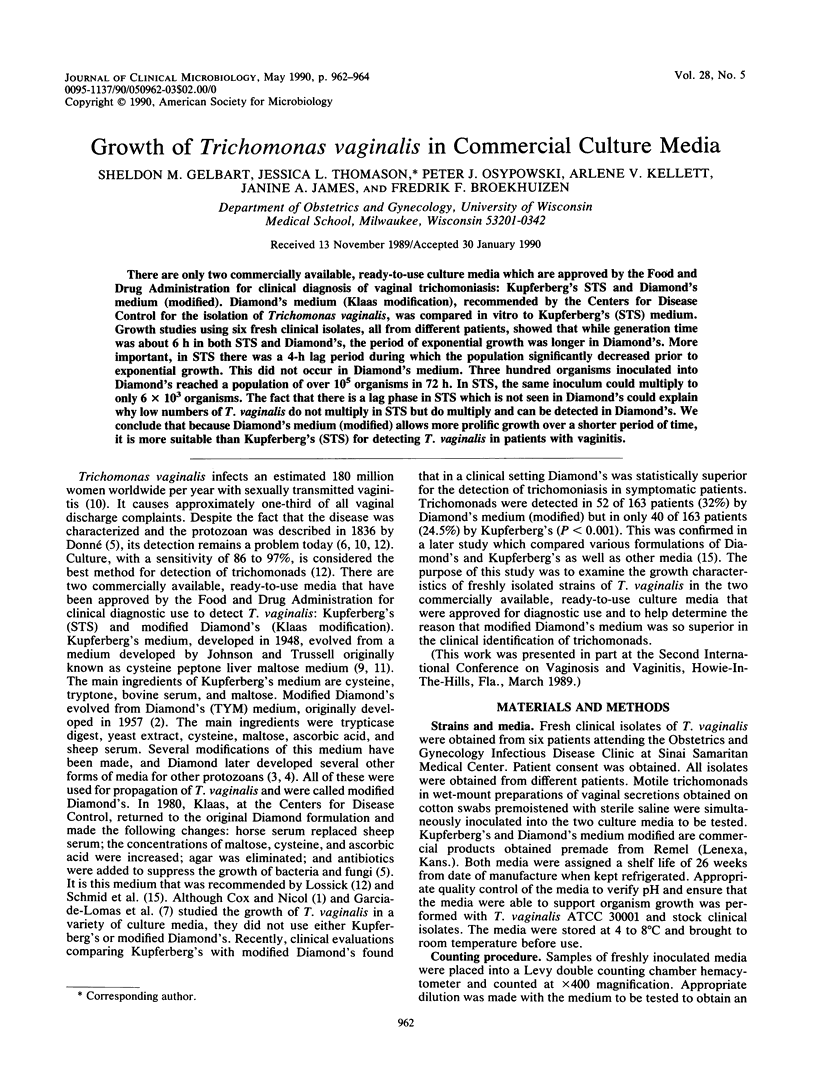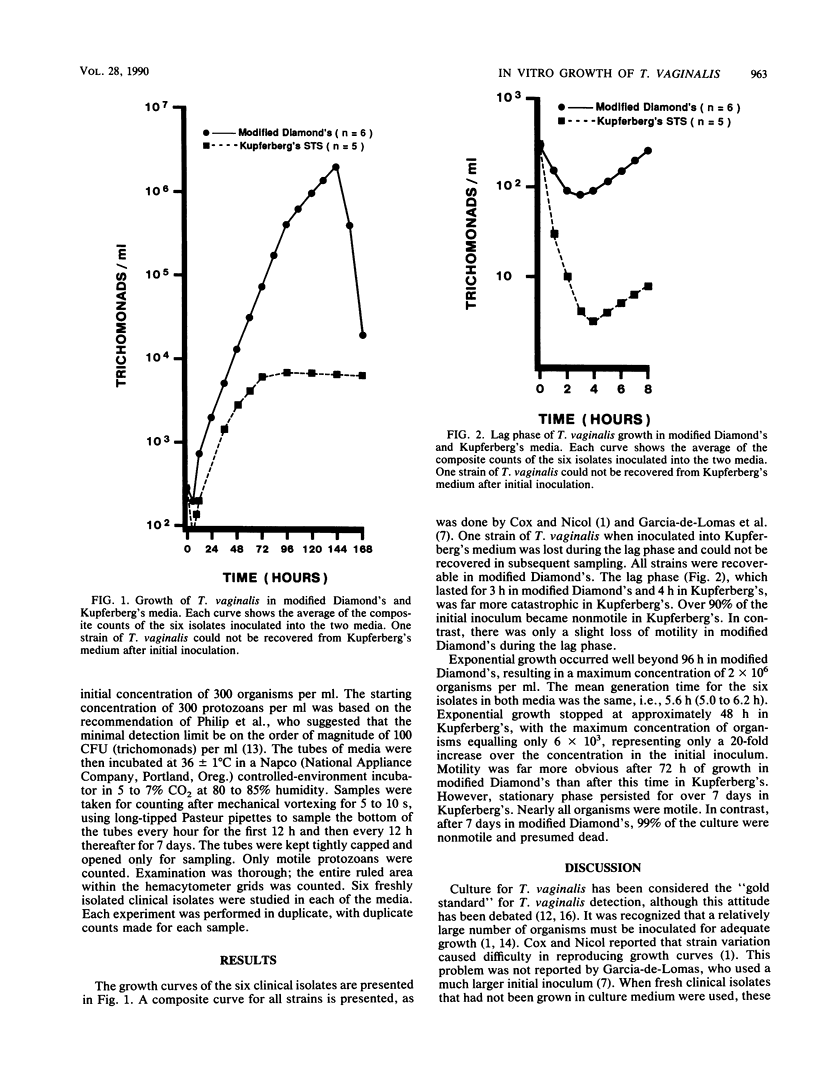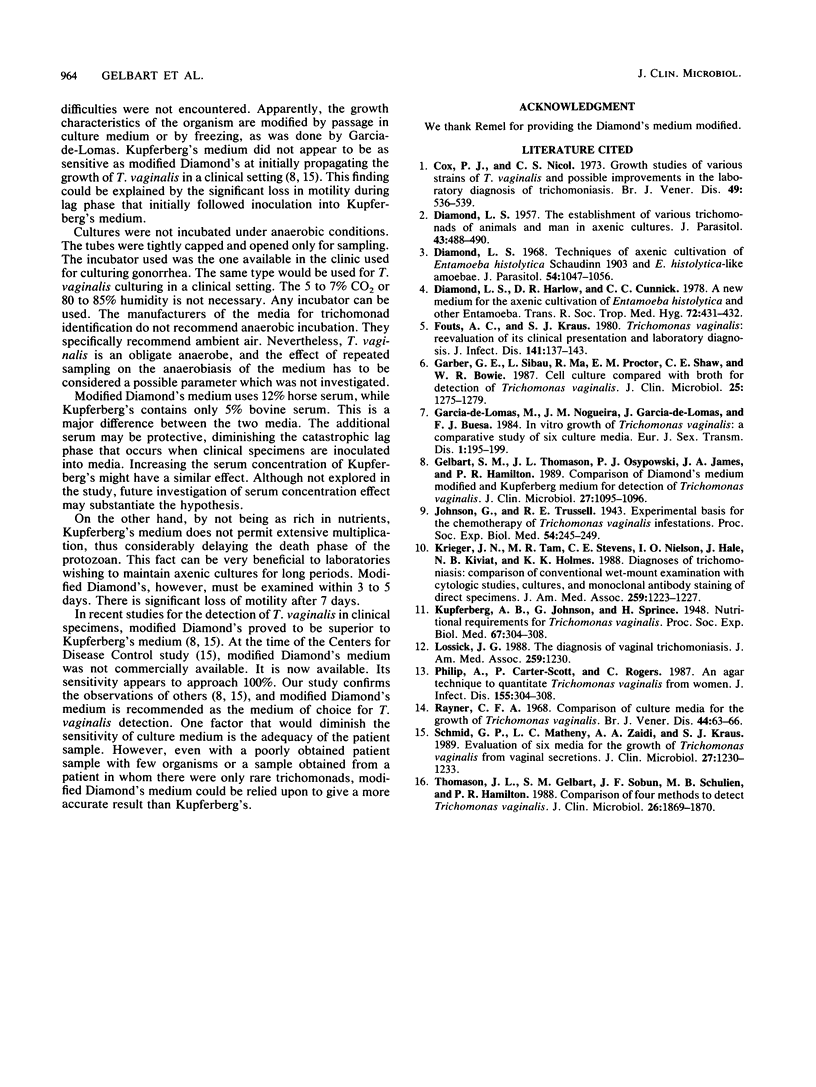Abstract
There are only two commercially available, ready-to-use culture media which are approved by the Food and Drug Administration for clinical diagnosis of vaginal trichomoniasis: Kupferberg's STS and Diamond's medium (modified). Diamond's medium (Klaas modification), recommended by the Centers for Disease Control for the isolation of Trichomonas vaginalis, was compared in vitro to Kupferberg's (STS) medium. Growth studies using six fresh clinical isolates, all from different patients, showed that while generation time was about 6 h in both STS and Diamond's, the period of exponential growth was longer in Diamond's. More important, in STS there was a 4-h lag period during which the population significantly decreased prior to exponential growth. This did not occur in Diamond's medium. Three hundred organisms inoculated into Diamond's reached a population of over 10(5) organisms in 72 h. In STS, the same inoculum could multiply to only 6 x 10(3) organisms. The fact that there is a lag phase in STS which is not seen in Diamond's could explain why low numbers of T. vaginalis do not multiply in STS but do multiply and can be detected in Diamond's. We conclude that because Diamond's medium (modified) allows more prolific growth over a shorter period of time, it is more suitable than Kupferberg's (STS) for detecting T. vaginalis in patients with vaginitis.
Full text
PDF


Selected References
These references are in PubMed. This may not be the complete list of references from this article.
- Cox P. J., Nicol C. S. Growth studies of various strains of T. vaginalis and possible improvements in the laboratory diagnosis of trichomoniasis. Br J Vener Dis. 1973 Dec;49(6):536–539. doi: 10.1136/sti.49.6.536. [DOI] [PMC free article] [PubMed] [Google Scholar]
- DIAMOND L. S. The establishment of various trichomonads of animals and man in axenic cultures. J Parasitol. 1957 Aug;43(4):488–490. [PubMed] [Google Scholar]
- Diamond L. S., Harlow D. R., Cunnick C. C. A new medium for the axenic cultivation of Entamoeba histolytica and other Entamoeba. Trans R Soc Trop Med Hyg. 1978;72(4):431–432. doi: 10.1016/0035-9203(78)90144-x. [DOI] [PubMed] [Google Scholar]
- Diamond L. S. Techniques of axenic cultivation of Entamoeba histolytica Schaudinn, 1903 and E. histolytica-like amebae. J Parasitol. 1968 Oct;54(5):1047–1056. [PubMed] [Google Scholar]
- Fouts A. C., Kraus S. J. Trichomonas vaginalis: reevaluation of its clinical presentation and laboratory diagnosis. J Infect Dis. 1980 Feb;141(2):137–143. doi: 10.1093/infdis/141.2.137. [DOI] [PubMed] [Google Scholar]
- Garber G. E., Sibau L., Ma R., Proctor E. M., Shaw C. E., Bowie W. R. Cell culture compared with broth for detection of Trichomonas vaginalis. J Clin Microbiol. 1987 Jul;25(7):1275–1279. doi: 10.1128/jcm.25.7.1275-1279.1987. [DOI] [PMC free article] [PubMed] [Google Scholar]
- Gelbart S. M., Thomason J. L., Osypowski P. J., James J. A., Hamilton P. R. Comparison of Diamond's medium modified and Kupferberg medium for detection of Trichomonas vaginalis. J Clin Microbiol. 1989 May;27(5):1095–1096. doi: 10.1128/jcm.27.5.1095-1096.1989. [DOI] [PMC free article] [PubMed] [Google Scholar]
- Krieger J. N., Tam M. R., Stevens C. E., Nielsen I. O., Hale J., Kiviat N. B., Holmes K. K. Diagnosis of trichomoniasis. Comparison of conventional wet-mount examination with cytologic studies, cultures, and monoclonal antibody staining of direct specimens. JAMA. 1988 Feb 26;259(8):1223–1227. doi: 10.1001/jama.259.8.1223. [DOI] [PubMed] [Google Scholar]
- Lossick J. G. The diagnosis of vaginal trichomoniasis. JAMA. 1988 Feb 26;259(8):1230–1230. [PubMed] [Google Scholar]
- Philip A., Carter-Scott P., Rogers C. An agar culture technique to quantitate Trichomonas vaginalis from women. J Infect Dis. 1987 Feb;155(2):304–308. doi: 10.1093/infdis/155.2.304. [DOI] [PubMed] [Google Scholar]
- Rayner C. F. Comparison of culture media for the growth of Trichomonas vaginalis. Br J Vener Dis. 1968 Mar;44(1):63–66. doi: 10.1136/sti.44.1.63. [DOI] [PMC free article] [PubMed] [Google Scholar]
- Schmid G. P., Matheny L. C., Zaidi A. A., Kraus S. J. Evaluation of six media for the growth of Trichomonas vaginalis from vaginal secretions. J Clin Microbiol. 1989 Jun;27(6):1230–1233. doi: 10.1128/jcm.27.6.1230-1233.1989. [DOI] [PMC free article] [PubMed] [Google Scholar]
- Thomason J. L., Gelbart S. M., Sobun J. F., Schulien M. B., Hamilton P. R. Comparison of four methods to detect Trichomonas vaginalis. J Clin Microbiol. 1988 Sep;26(9):1869–1870. doi: 10.1128/jcm.26.9.1869-1870.1988. [DOI] [PMC free article] [PubMed] [Google Scholar]


